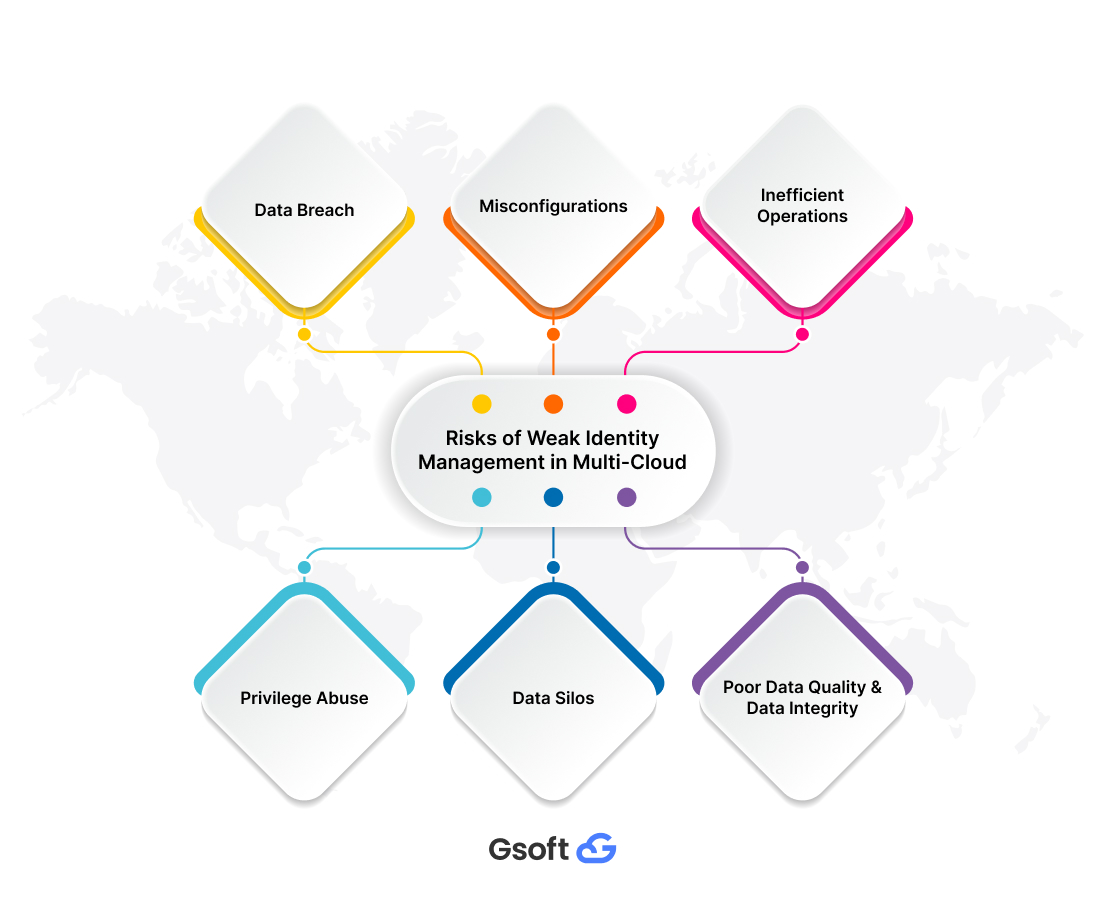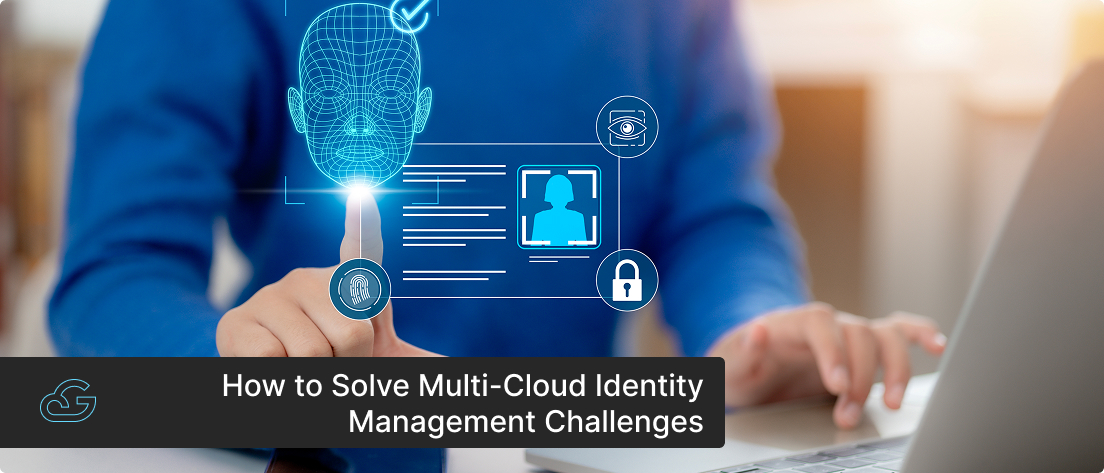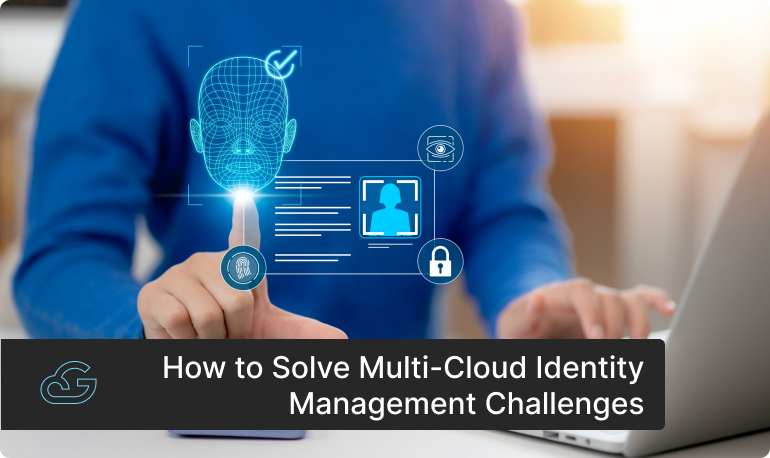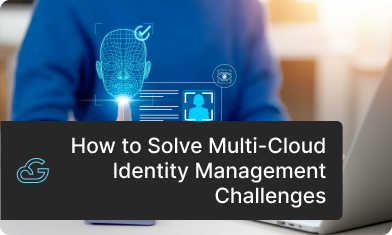Blogs / Hybrid Cloud
How to Solve Multi-Cloud Identity Management Challenges
By
Harish K K
Posted: February 20, 2025
• 6 Minutes
“Multi-cloud” is the go-to cloud deployment model for modern-day organizations. In this model, you are essentially combining cloud solutions from different service providers, enabling you to build a cloud strategy that is diverse, cost-effective, and efficient. However, to reap the benefits of this robust cloud strategy, you must place special emphasis on one crucial aspect—identity and access management.
But as your organization grows and cloud estate rapidly proliferates along with it, managing all the identities and authenticating access to multiple stakeholders is going to be tricky. In this blog, we will dive into the intricacies of multi-cloud identity management and share proven strategies that cloud architects and security professionals can implement to solve these challenges.
What is Multi-Cloud Identity Management?
Multi-cloud identity and access management (IAM) is the process of handling user identities and streamlining access rights across multiple cloud platforms by using various tools, techniques, and strategies. With a unified multi-cloud IAM approach, you can ensure interoperability between cloud solutions, allowing you to leverage cloud resources seamlessly without disrupting user experience and creating security gaps.
Major Identity & Access Management Challenges in Multi-Cloud Environments
- Different Access Control Mechanisms: Each cloud service provider treats access controls differently. Security policies might change, and the definition of each role might differ from one cloud environment to another. This disparity can fragment the access controls of your multi-cloud ecosystem, impacting the user experience and disrupting operations.
- Lack of Visibility: Things can quickly go out of control in a multi-cloud environment. Your DevOps team might rapidly spin up virtual machines or storage systems from different cloud service providers as the business requirements evolve. This way, you will lose track of user identities and access rights, creating security gaps.
- Risk of Over-Privileged Accounts: These are accounts that come with special access rights. But this is achieved by tightly configuring these accounts with several constraints such as time-bound access and data-specific restrictions. In a multi-cloud environment, it is difficult to ensure that these constraints get carried over, potentially leading to privileged accounts having excessive access rights and resulting in privilege abuse.
- Compliance Penalties: When dealing with access controls in a multi-cloud environment, there is a high chance that you might end up facing compliance penalties. This is because each cloud service provider, even though they all possess the same compliance certifications, might offer audit trails and reports in a different manner. This makes it challenging to maintain a unified compliance posture across your multi-cloud ecosystem.
- Non-Human Entities: Apart from human users, you will also have to manage access for non-human entities like APIs, applications, services, etc. But in a multi-cloud environment, integrating all these entities together and orchestrating access is going to be incredibly difficult. For instance, API authentication methods may differ between clouds, and an application configured to work with one cloud’s authentication system might fail when trying to access resources in another cloud, resulting in your operations breaking down.
- Lifecycle Management: User accounts go through different stages during their lifecycle in your organization. At each stage, their access rights must be updated accordingly. This means ensuring seamless provisioning when they join, adjusting permissions as their roles evolve, and revoking access when they leave. In a multi-cloud environment, enforcing these access controls consistently across all platforms is challenging, making lifecycle management a complex task. For instance, an employee leaving the organization might have their access revoked from cloud-based collaboration tools but still retain permissions to critical data storage in another cloud, creating potential security risks.

Proven Strategies to Overcome Multi-Cloud IAM Challenges
-
Establish a Single Source of Truth (SSOT) for Identities:
Managing identities across multiple cloud platforms is challenging due to
differences in how each provider handles user roles. The key to overcoming
this is to establish a Single Source of Truth (SSOT)—a centralized identity
directory that keeps user roles consistent, accurate, and synchronized across
all cloud environments.
SSOT helps prevent identity sprawl, ensures seamless user provisioning and de-provisioning, and eliminates duplicate or orphaned accounts. With a single authoritative dataset, you can reduce inconsistencies when users change roles or leave, maintaining identity integrity across multi-cloud environments.
-
Automate Policy Enforcement:
While SSOT ensures identity consistency, policy enforcement is about maintaining
control over access rights. Each cloud provider has its own IAM structure,
making it difficult to implement uniform security policies.
To solve this, you should automate policy enforcement, which makes sure that access controls are applied centrally and updated dynamically based on real-time conditions. To enable this, you must employ:
- Policy-as-Code to define security policies programmatically
- Attribute-Based Access Control (ABAC) and Role-Based Access Control (RBAC) for dynamic and granular permissions
- Zero Trust principles and Multi-Factor Authentication (MFA) to ensure access is granted only when necessary and continuously verified
By automating policy enforcement, organizations can reduce misconfigurations, maintain compliance, and adapt to evolving security needs without manually managing access across different cloud providers.
-
Implement Cross-Cloud Access Controls:
Ensuring seamless operability is another major challenge that is associated
with multi-cloud identity management. If your identities aren’t integrated
properly, it can lead to the formation of data silos, essentially breaking
down your operations.
You can overcome this by implementing cross-cloud access controls that are aligned with each cloud provider’s unique IAM model and authentication mechanisms. Here are some of the ways in which you can achieve this:
- Use “Identity Federation” to allow users to authenticate once and access multiple cloud platforms without managing separate credentials.
- Standardize how user roles and permissions are transferred between IAM models to avoid privilege mismatches.
- Leverage Open Standards protocols like OIDC (OpenID Connect), SAML (Security Assertion Markup Language), and SCIM (System for Cross-domain Identity Management) to ensure smooth integration of identities, applications, and third-party security tools across different cloud providers.
-
Standardize Compliance & Reporting:
Major cloud service providers follow different methodologies in maintaining
compliance reports. But if you are operating with a multi-cloud model, you
must make sure that you are consolidating all these reports in a standardized
manner. This will help you maintain consistent compliance documentation,
regardless of how each provider structures their audit logs and reports.
When auditors request compliance evidence, you can quickly generate comprehensive reports that cover your entire cloud ecosystem rather than piecing together different formats from each provider. This approach not only saves time but also ensures you don’t miss critical compliance requirements due to disparate reporting methods.
-
Implement A CIEM Solution:
A multi-cloud environment is highly susceptible to privilege abuse stemming
from excessive access rights. To overcome this problem, you must deploy a
Cloud Infrastructure Entitlement Solution (CIEM). It is a security tool that helps organizations manage and control
permissions, entitlements, and identities in multi-cloud environments.
With a robust CIEM tool, you can attain deep visibility and control over all your user identities and permissions. You can monitor access patterns and infrastructure usage, which will enable you to spot over-privileged accounts, unused permissions, and anomalies. Additionally, with a CIEM solution, you can automate the removal of over-privileged accounts and enforce Just-in-Time (JIT) access controls, which will help you effectively negate privileged threats.
-
Automate Identity Lifecycle Management:
Manual identity lifecycle management processes are bound to result in minor
errors and inconsistencies. But in a dynamic multi-cloud environment, these
seemingly minor errors could have devastating consequences. Therefore, it
is important to automate the entire identity lifecycle—from initial provisioning
when an employee joins to de-provisioning when they leave.
For example, when a new employee joins, automated workflows can create necessary accounts and assign appropriate permissions across all cloud platforms simultaneously. Similarly, when an employee leaves, automation ensures their access is promptly revoked across all cloud environments, preventing security risks from lingering access. This systematic approach reduces administrative burden, eliminates manual errors, and ensures consistent identity management across your multi-cloud ecosystem.
By implementing these strategies, you can overcome the major identity management challenges in a multi-cloud environment. However, to further strengthen your approach, adopting key best practices is just as crucial. Let’s take a look at them in the next section.
Best Practices for Effective Multi-Cloud Identity Management
- Conduct Continuous Identity Audits & Hygiene Checks: Even with a Single Source of Truth (SSOT) and strict access policies in place, misconfigurations, outdated permissions, and orphaned accounts can still emerge. Therefore, you must perform regular identity hygiene checks to discover inactive accounts, excessive privileges, and shadow IT risks.
- Establish Proactive Threat Detection & Incident Response Mechanisms: Proactive threat detection and incident response are two core components of multi-cloud Identity management. Set up AI-driven behavioral analytics to identify any threats or privilege abuse before they materialize into full-fledged security incidents. Additionally, create and incorporate robust incident response workflows that automatically trigger remediation actions.
- Implement Adaptive Authentication: Look for opportunities to move beyond conventional MFA mechanisms. By embracing “adaptive authentication”, you can create more flexible access controls that are dynamic, factoring in the context—such as user location, device trust level, behavioral patterns, etc. This way, you can enhance security without disrupting user experience.
Future Trends in Multi-Cloud Identity Management
Multi-cloud Identity and Access Management (IAM) is constantly evolving with new technologies and security challenges. The integration of automation, AI and ML-driven behavioral analytics, and adaptive authentication showcases how it is moving towards more intelligent, proactive security models. But what does the future look like for the multi-cloud IAM space? Here are some of the future trends that we believe will emerge in the coming years.
- GenAI-Powered Compliance Reporting: GenAI tools could prove extremely beneficial for multi-cloud IAM, especially with compliance reporting. Due to its advanced capabilities as a large language model that can respond to user prompts, these tools can be configured to automate compliance data consolidation across various cloud platforms and create real-time reports within a relatively short time span. It can also be used to spot compliance gaps and recommend corrective actions. This drastically reduces human effort while enhancing accuracy and response time.
- Decentralized Identity Management with Blockchain: Most IAM models and solutions available in the market today rely on centralized servers. That is, cybercriminals can shift their focus from users and try to exploit these servers to extort your sensitive data. Blockchain technology can provide a solution to this problem. It inherently functions on decentralized architecture and distributed ledgers, which enables you to create Self-sovereign identities (SSI), where users can control their credentials. This way, you don’t have to worry about the IAM solution provider’s security.
- Increased Adoption of Password-Less Technologies: Due to their high vulnerability to phishing and other forms of cyber-attacks, passwords are slowly going to be replaced by password-less technologies. This includes passkeys or security tokens powered by cryptographic methodologies and biometric access (fingerprint, facial recognition, etc.). These password-less technologies are extremely secure and can potentially offer a much-improved user experience.
Experience Seamless Multi-Cloud Identity Management with Gsoft
As you might have understood by now, multi-cloud identity management is a highly complicated process. You must establish access controls and policies, manage various user roles, and monitor your multi-cloud environment, all the while maintaining operational efficiency. On top of all this, you need to have solid knowledge of the cloud computing world—the solutions that are compatible with each other, APIs and third-party tools that you must use, etc.
At Gsoft, we have dedicated cloud experts who can take this burden off you. As a multi-cloud service provider, our team will work closely with you to understand your requirements and take control of your multi-cloud identity and access management.
Our multi-cloud identity and access management framework includes:
- A unified approach to managing user identities across multiple cloud environments
- Establishing a Single Source of Truth (SSOT) for identity management
- Integrating seamless access controls and policies with a Zero Trust Architecture
- Implementing SSO, Identity Federation, RBAC, ABAC, MFA, etc.
- Automating identity lifecycle management
- Real-time monitoring and analytics
- Compliance adherence
Are you looking for a cloud service provider to help solve multi-cloud identity and access management challenges? Schedule a call with us at www.gsoftcomm.net.


Get Know More About Our Services and Products
Reach to us if you have any queries on any of our products or Services.











